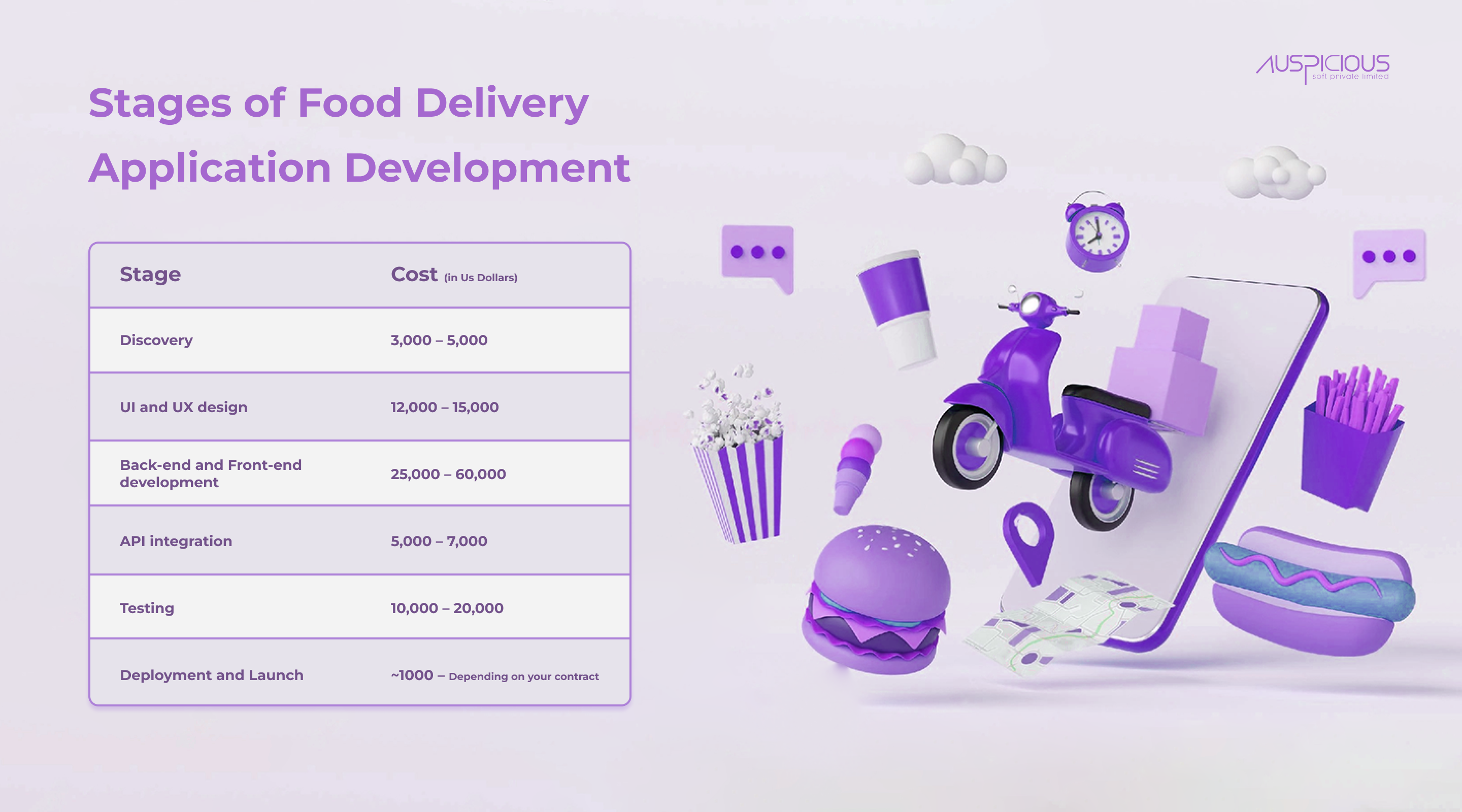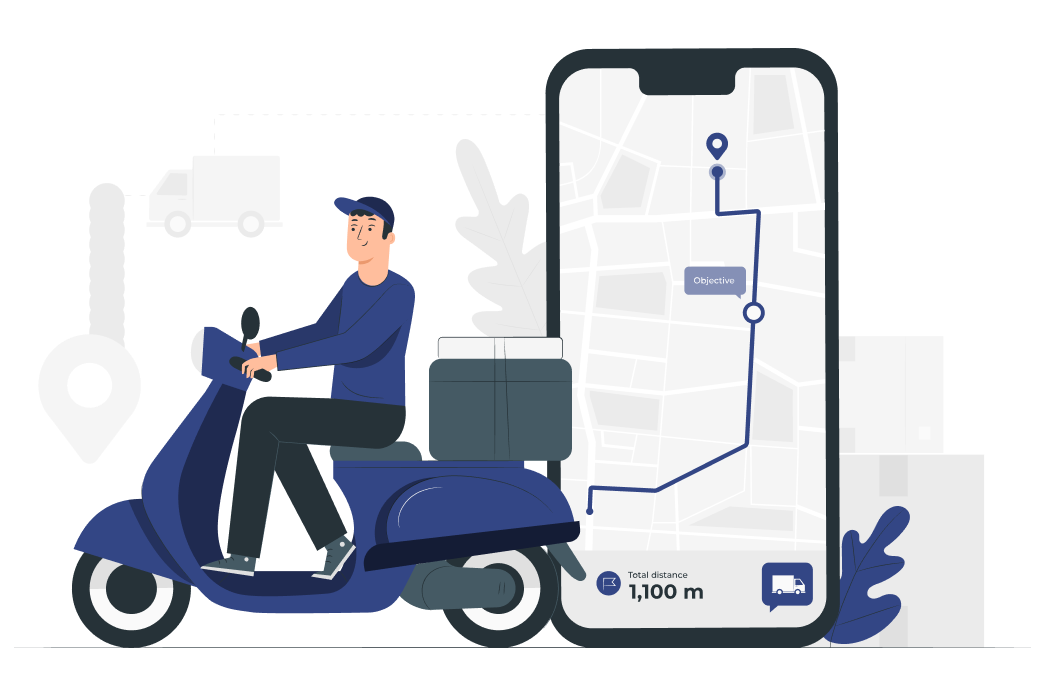How Much Does It Cost To Build A Food Delivery App Like DoorDash, Ubereats or GrubHub?
“How much long does it take to develop a food delivery mobile application like UberEats or GrubHub?” It is one of the most commonly asked questions after learning how much app development costs.
According to allied market research, the mobile application market is expected to reach 407.31 billion USD over the next four years, with an estimated CAGR of 18.4%. A person spends 3-4 hours per day on their phone on average and they have come to rely on mobile apps for on-demand services and other day-to-day needs. This has altered the way businesses have begun to view the future. They are now embracing the digital world and want to create an app for their company.
As a result, it becomes necessary to bring the business online in order to provide the convenience that the customers seek.
Because of digitalization, businesses can now use mobile applications to automate their operations and management with minimal human interaction. As a result, the overall management of business operations becomes smooth and effortless.
There is no set formula for calculating the time required to develop a food delivery mobile app. Several factors are considered when calculating how much long does it takes to develop a mobile application.

How Much Does It Cost To Build A Food Delivery App in 2023?
Though it depends upon the required features, technical architecture, and scope of the food delivery app, the development process may seek around 550 to 800 hours. On outsourcing, the development project, around 6-12 months will be sufficient to complete the project. If the development team will use the database and features APIs like Google Places along with readymade software development kits, the efforts as well as time can be reduced effectively.
Here is how you can make stages for the development process –

It can be an additional cost that can belong to the complete development process. Here the following factors may matter for the final business.

Concluding all, the article describes the influencing factors for the timeline of app development. Even non-technical business owners can also assess their project timelines with a better understanding with this. Before proceeding with the process, you should consider the app’s type on the basis of your requirement.
Requirements For Food Delivery App Development
Business owners spend anywhere from three months to more than a year developing their applications. But don’t worry, because each application model is unique, your application may only take two months to develop by a mobile app development company.
Some applications like food delivery apps are simple to create because they take less time to develop. Furthermore, the average time to develop an app is less than three months. The timeline can be extended to 9 months if your application requires additional features to gain customer loyalty.
On the other hand, for some applications, such as enterprise-level applications requiring extremely complex features, the development timeline can be extended to more than a year.
There is no formula that can tell you whether your application is small, medium, or large (Enterprise version). However, you can estimate your application type using the following formula.
First, determine how many features you want to include in your application; if you have 8 to 10 features, your application is small. Similarly, if your app requires 10 to 15 features, it is considered medium-sized. Finally, if your app is expected to have more than 15 features, it is classified as an enterprise app.
Select the Best Development Platform
It is critical to choose the development platform you want to use. The mobile app development company should be aware of your target audience’s operating system, whether iPhone or Android. If you are not a technical person, please be aware that the iPhone application will not run on Android and vice versa.
Developing an app on a single platform may result in a loss for your company. We strongly advise you to develop your app for both platforms. The native app development approach is used if you choose to develop your mobile app on both platforms separately.
When a company does not have enough funds to develop an app, it may opt to develop a single app that runs on both platforms. This is referred to as a cross-platform development strategy.
The time required for app design and development is significantly less in a cross-platform approach than in a native approach. This is because development for the Android and iOS platforms is done separately in the native approach.
How Do You Decide Which Approach to Take?
If you have a large budget and do not want to compromise on app performance, the native application development approach is ideal. Furthermore, choose this approach if your company is medium-sized or large.
You can also choose cross-platform app development. However, we strongly recommend the native development approach from every angle.
Now, let’s understand your most frequent question – ‘How much long does it take to develop a mobile application?’. There are numerous factors that we consider when developing a timeline. Stay with us to find out the exact time it takes to develop an app.
Start-To-End The Development Process And Its Timeline
An application goes through several stages of development. Each stage of the process contributes to the total time required to develop an application. Because each stage is interdependent on the others, they cannot be skipped.
Here’s how the procedure works:
Stage One: 1 – Development Options
To develop an application, one must first determine which option is best suited to their needs.
You can build an app yourself, outsource development to a company, use an app builder, hire a freelancer, or even hire an in-house team. Each development method has advantages and disadvantages that affect the app development timeline.
We will walk you through all of these options, but the decision is entirely up to you.
The first option is as follows:
1. Doing It Yourself
If you are familiar with the technical aspects of development, developing an application yourself is a viable option. However, according to surveys, this is not a recommended option. This is because an application goes through several stages before it is released, including design, development, and deployment.
A minor deficiency in any of these fields has a negative impact on the application’s overall interface. As a result, the services of a specialist will be required at some point. This raises the overall development cost and, more importantly, the time required to create an app.
2. Using An App Builder
App builders are a good choice if your application has limited functionality and static data (that does not change over time). Businesses that do not have the resources to develop an application from the ground up usually prefer this option.
However, businesses that require custom functionality for their application are limited to this option. As a result, they require assistance from an outside technical expert. This indirectly lengthens the time it takes to develop a mobile app.
3. In-House App Development Team
When you have a large budget, developing an application in-house is one of the best options because it produces the best results. The only drawback to this option is that it takes time and a lot of effort to find the right team to join your company and develop an application. And if you hire the wrong people, the average time to build an app will undoubtedly increase.
4. Outsourcing
This is the preferred option for all types of development needs. Businesses must use the internet to find the best app development companies. One must examine their portfolio and choose the best company for their needs.
When choosing a development agency, make sure that the company has a competent team of experienced developers. This team should be able to work on any platform of your choice while maintaining transparency at all stages of development.
Stage: 2 – Documentation
Documentation is, without a doubt, the most important aspect of the development process. Many app developers and businesses, however, overlook and skip this stage.
The documentation must include all of the application’s requirements. A properly structured state means less time spent struggling to understand the project’s requirements.
If you are collaborating with an app development partner, include company contact information and other pertinent information in your project brief.
The following points must be included in the documentation. This ensures that the development partner fully comprehends the project.
- Your project’s objective and success metrics
- Solicitation of proposals (RFP)
- A confidentiality agreement (NDA)
- Price range
- Estimated delivery time
You should probably double-check the “request for proposal.” The development agency’s bidding and quotation are based on the RFP submitted by the businesses. The RFP serves as the foundation upon which you can negotiate with the development company. RFP takes authority away from a development agency in order to do things differently. You can also encourage development partners to make additional suggestions and ideas.
Stage: 3 – Analyze And Validate
People believe that idea analysis means validating the possibility of technological implementation, but it is far more than that.
Business analysts contact app owners to learn about their market research, app users, and app problems. Following that, the business analyst analyses the concept and assesses the likelihood of the app’s success. Analysts investigate platforms (native or cross-platform) in order to create an application based on a target audience.
Following the selection of the platform, the business analyst will calculate the estimated timeframe for development.
Following that, they extract the most important features of the app, known as MVPs. Later, business analysts confirm that no features are interfering with the app’s performance.
Stage: 4 – Design
Because the end-user interacts with an app visually, design is an essential component. Customers are more likely to switch to competitors if an application has an unappealing design.
During the design stage, app designers curate two to three appealing combinations and test their user experience.
One can expect to get the best design for their application based on the results of user experience tests. This design testing is carried out based on various user needs criteria.
By the end of this stage, businesses have gained adequate clarity for their final application, such as
- Do the app’s features provide any value to users?
- Is it difficult for users to navigate the application?
- What are the benefits of using the application?
- How did the user feel while using the application?
Stage: 5 – Development
You can avoid major changes during the app development process if you follow the previous four steps correctly. This is due to the fact that making changes to the app plan after the development process has begun can significantly extend the development timeline.
The development of an app is divided into two stages: the front end and the back end. The front end of an app is what the user sees and interacts with while using it. In contrast, the back end refers to all of the background processes that occur while interacting with an app.
Signup, for example, is a page that displays buttons and text fields and is referred to as the front end. When the user clicks the button, a background process begins to work in the background to provide a quick response. This is referred to as the back end. When you receive a response from the back end, you will be redirected to the desired page.
When developing an application, both the front and back ends are important. A user cannot interact without the front end, and an app cannot function without the back end.
Stage: 6 – Testing
The application’s performance is evaluated during the testing stage using various predefined criteria. This ensures that all bugs are identified and eliminated prior to app deployment, resulting in a smooth user experience.
Testing aids in gaining clarity on a variety of app success questions, such as:
- Is it possible for the application to crash in the middle?
- Is it simple to hack the information in the app?
- What if some of the application’s features don’t work properly?
- What if the user interface design is flawless, but the development isn’t?
- How well does the app perform?
These are a few important considerations when developing applications. Before releasing an app, it must go through alpha and beta testing to ensure that it is error-free.
You may encounter a bug after deployment if you skip the testing stage. This can add to the average app development timeline.
Stage: 7 – Deployment
Both Android and iOS are two of the most popular platforms for app deployment. You must apply in the Play Store to have your Android application live. The same is true for an iOS app in the App Store.
Both have policies that require time to review applications. In general, the Play Store takes less time than the App Store. The information needed to apply is listed below.
- Icons
- App Description
- Screenshots
- Image or video demonstration
- Optimization for the App Store
The primary thing to remember here is that Apple has a rigid and detailed review process for all iOS apps.
In some cases, AppStore can reject the proposed applications to improve or remove certain features. In this case, the final app development timeline will be extended.
This was a comprehensive and detailed response to the question, “How much long does it take to develop a mobile application?” But this is not the end of the story. We will now go over a few issues that slow down the development of an application.
Finally, How Long Does It Take To Create An App?
The online food delivery app market is growing rapidly and some surveys have projected its growth to reach up to 13000 million US dollars in 2024. They can even be the front runners in market capitalization. The Statista report suggests around 69.9 million users in the online food delivery platform to the consumer market. It is big enough to bring an opportunity and get more users at a lower acquisition cost, comparatively.
Not that you are all familiar with the concept of coding and the fact that it is a time-consuming task. This article discussed the various factors that influence how long apps take to build and what can be the Cost of mobile app development.
Each factor has a number of options to choose from, and each option has its own timeline. The app owner has complete control over these options. Again, incorrectly evaluating and failing to comprehend the factor can result in massive losses and even delay the application’s timeline.
You now know which factors can aid in the faster development of an app and which can stymie the development process. We attempted to answer almost all of your questions about the development timeline.
We hope you found the information we presented to you useful. Now you have a rough idea of how many hours it takes to develop an app, which is a frequently asked question.



